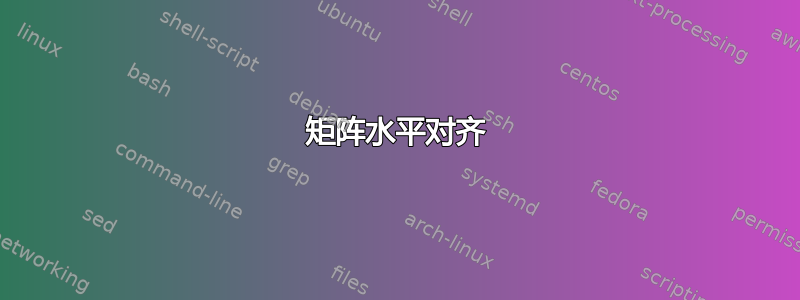
我正在尝试使用高斯TeX 包显示矩阵。我对以下代码有两个问题(不太重要):
\usepackage{amsmath}
\usepackage{gauss}
\begin{document}
\begin{equation}\begin{gmatrix}[b]
1 & 0 & 0 & 0 & \frac{4}{5} & \text{\small{-}}\frac{3}{5} & \frac{2}{5} & \text{\small{-}}\frac{1}{5} \\
0 & 1 & 0 & 0 & \text{\small{-}}\frac{3}{5} & \frac{6}{5} & \text{\small{-}}\frac{4}{5} & \frac{2}{5} \\
0 & 0 & 1 & \frac{3}{4} & \frac{1}{4} & \text{\small{-}}\frac{1}{2} & \frac{3}{4} & 0 \\
0 & 0 & 0 & 1 & \text{\small{-}}\frac{1}{5} & \frac{2}{5} & \text{\small{-}}\frac{3}{5} & \frac{4}{5}
\rowops
\add[\cdot ({-}\frac{3}{4})]{3}{2}
\end{gmatrix} \cong
\begin{gmatrix}[b]
1 & 0 & 0 & 0 & \frac{4}{5} & \text{\small{-}}\frac{3}{5} & \frac{2}{5} & \text{\small{-}}\frac{1}{5} \\
0 & 1 & 0 & 0 & \text{\small{-}}\frac{3}{5} & \frac{6}{5} & \text{\small{-}}\frac{4}{5} & \frac{2}{5} \\
0 & 0 & 1 & 0 & \frac{2}{5} & \text{\small{-}}\frac{4}{5} & \frac{6}{5} & \text{\small{-}}\frac{3}{5} \\
0 & 0 & 0 & 1 & \text{\small{-}}\frac{1}{5} & \frac{2}{5} & \text{\small{-}}\frac{3}{5} & \frac{4}{5}
\end{gmatrix}\end{equation}
\end{document}
它看起来像这样:

\text{\small{-}}我通过使用而不是 来稍微绕过对齐-,以使分数出现在彼此之下,但它们仍然不能很好地排列,并且矩阵需要更多的垂直空间,但我似乎无法弄清楚如何做到这一点。任何帮助都将不胜感激 :-)
答案1
这个gauss包似乎阻碍了简单的答案。这里有一个解决方案,虽然不是很好,但很有效:\text{\small{-}}用\llap{-}(这将产生你想要的对齐方式)替换所有,然后为每一行添加一个支柱:
\documentclass{article}
\usepackage{amsmath}
\usepackage{gauss}
\newcommand\mystrut{\rule{0pt}{2.5ex}}
\begin{document}
\begin{equation}\begin{gmatrix}[b]
1 & 0 & 0 & 0 & \frac{4}{5} & \llap{-}\frac{3}{5} & \frac{2}{5} & \llap{-}\frac{1}{5} \mystrut \\
0 & 1 & 0 & 0 & \llap{-}\frac{3}{5} & \frac{6}{5} & \llap{-}\frac{4}{5} & \frac{2}{5} \mystrut \\
0 & 0 & 1 & \frac{3}{4} & \frac{1}{4} & \llap{-}\frac{1}{2} & \frac{3}{4} & 0 \mystrut \\
0 & 0 & 0 & 1 & \llap{-}\frac{1}{5} & \frac{2}{5} & \llap{-}\frac{3}{5} & \frac{4}{5} \mystrut
\rowops
\add[\cdot ({-}\frac{3}{4})]{3}{2}
\end{gmatrix} \cong
\begin{gmatrix}[b]
1 & 0 & 0 & 0 & \frac{4}{5} & \llap{-}\frac{3}{5} & \frac{2}{5} & \llap{-}\frac{1}{5} \mystrut \\
0 & 1 & 0 & 0 & \llap{-}\frac{3}{5} & \frac{6}{5} & \llap{-}\frac{4}{5} & \frac{2}{5} \mystrut \\
0 & 0 & 1 & 0 & \frac{2}{5} & \llap{-}\frac{4}{5} & \frac{6}{5} & \llap{-}\frac{3}{5} \mystrut \\
0 & 0 & 0 & 1 & \llap{-}\frac{1}{5} & \frac{2}{5} & \llap{-}\frac{3}{5} & \frac{4}{5} \mystrut
\end{gmatrix}\end{equation}
\end{document}
(内置的\strut有点太小,所以我定义了一个更大的\mystrut。)
答案2
获得更多垂直空间的一种方法是使用包\extrarowheight中的array。语法是\setlength{\extrarowheight}{x},其中x是度量(例如 2pt、3pt 等)。只有当其值加上\baselineskipx\arraystretch大于单元格的实际高度时才会产生效果。我通常会添加两个或三个点,这样可以使分数适当分开。


